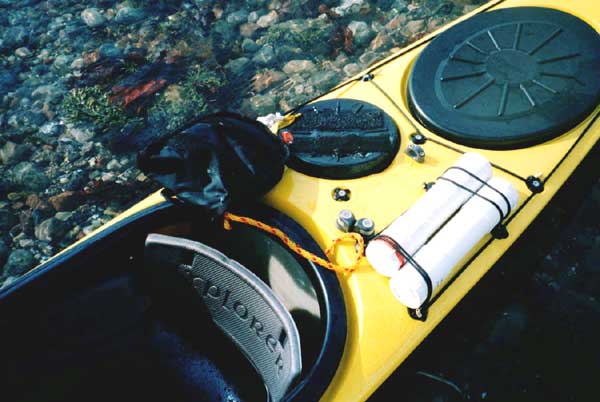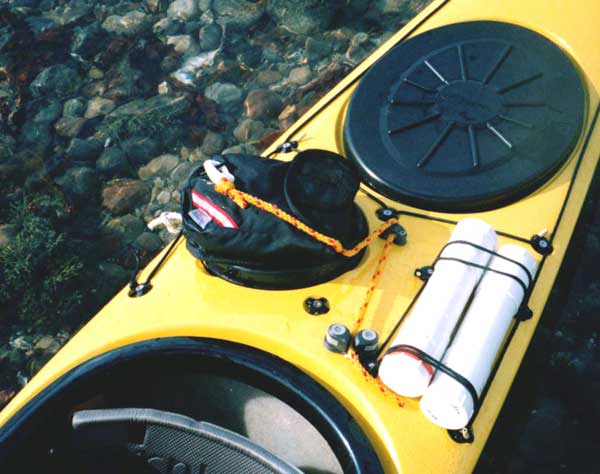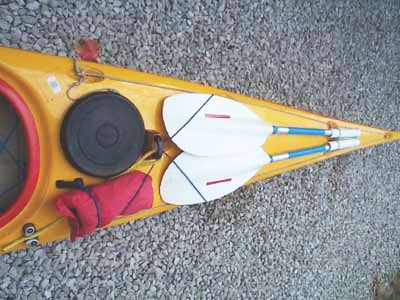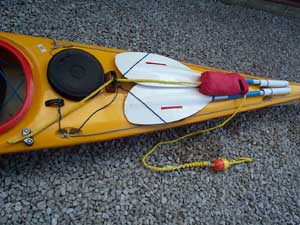"Boat specific” systems require some boat outfitting
and the pictures below show a simple system that only requires a cam-cleat
and a bulls-eye. Most of the major sea kayak manufacturers or retailers can
supply the necessary hardware or a chandlers will have them too. I used stainless
steel machine screws with large stainless washers and nuts to secure to the
boat. A little silicon under the fittings ensures waterproofing. The underdeck
area where the fittings attach has not been re-inforced on my boat and so
far the fittings are still secure after several years and some serious shock
loadings. Some boats may need a little additional fibreglass of course.
The line uses a cord loop at the stern to take a bight of
line back towards the cockpit where a small krab is used to retain it. The
main towing hook (a large krab) is held with a loop made in excess deck line.
The line float stops the hook end sinking if you drop it, saving you having
to retrieve the full length.
|
 |
|
General layout – line passes thro a bulls-eye on the centre line of
the boat so that the fulcrum and tow point is close to the paddler and
on the centre line of the boat. A quick release cam-cleat on the port
side behind the cockpit allows the tow to be released quickly merely
by lifting the end of the line clear of the cams.
I have severe
reservations about systems that can’t quick release and trying to get
to a clip mounted behind me on the boat centre line would seem excessively
difficult. But if it works for you - - -
(The white
tubes are to hold the ends of deck mounted split paddles and the black
strips by the cam cleat are Velcro for the storage bag I now use) |
|

|
 |
 |
|
Stern loop to take a bight of line back to the cockpit. The toggle loop
could also be used. |
Mini-krab to secure bight, also showing line float & bungee shock
absorber. |
Towing hook, with retention loop. Realistically, this might be better
on the port side as it fouls the skeg slider on this boat. |
This is a straightforward, simple system that is easy to
deploy – on the negative side, deployment requires two actions; unhooking
the mini-krab and unhooking the main tow-hook.
It is however fairly foolproof, inexpensive and efficient
in that the towing point (the bulls-eye) is close to the centre line of the
boat and close to the paddler, and that minimises the turning effect which
would be evident were the line threaded through the rear toggle loop. This
particular boat (a Quest) has a metal plate right behind the cockpit which
is intended as a security point. I considered using this initially as a substitute
for the bulls-eye but found the rope had a tendancy to snag under load when
trying to quick release.
I also considered using the security point as the tow line
attachment point, with a quick release snap-link - it didn't work safely or
efficiently for me so I decided not to.
By using the toggle loop, or an extra loop on a deck fitting
as shown, to take a bight of line back to the cockpit area you are able to
increase the available length to twice that available if you only take the
line back from the end of the boat. It also means that your towing furcrum
is close to the cockpit.
Although it's a simple and straighforward system, the deck
mounted line is a nuisance when you are opening the centre hatch and line
down the side of the boat gets in the way more often than you’d expect.
It’s also a little restrictive as to maximum length in that
the length of the boat dictates the available line. Using more rope with a
daisy chain is an option, the end being held by the mini-krab, but that is
adding complexity and depends on being able to open the clip to allow the
daisy chain to stream clear.
You’ll still be hard pushed to get more than about 9 meters
overall - the line in the picture is just over 7 meters.
This set up was designed to put the float and the mini-krab
for the bight at about the same position as my hip so as to try and keep the
area beside me (in my paddling arc) as clear of line as possible while also
letting me grab the tow hook easily. Having some clear line between the tow
hook and the float gives more flexibility for attaching and you can run the
line thro a couple of toggles if the situation requires it and hook it back
on itself.
Incidentally, on the subject of physically joining two boats
together as a matter of course, there is a school of thought that suggests
it may be an efficient way to tow a pair of boats by running the tow line
thro the deck lines of the boats as it saves the supporting paddler the stress
of trying to hold the boats together. If you do that, it's probably worth
making sure that the supporting paddler is able to slide himself forward enough
to be able to detach from the casualty, and then take hold of the line to
clear it from his own deck line. That would mean that any float and bungee
used as a shock-absorber should be well away from the hook to give enough
room to do this.
It would also be worth while considering whether to clip
into a deckline, rather than into the toggle. Toggle ropes tend to wear and
they're often neglected and of dubious strength. When clipping into the deckline,
clip only one strand. If you clip both strands and the bow fitting fails,
you lose the tow. This discussion
includes pictures of the set-up and some comments on use.
I’ve found I prefer the large krab as a tow hook as it can
be snapped on much more easily and quickly than the smallish stainless steel
hooks that are generally recommended. This is especially true with cold hands
in big seas. It does have to be rinsed after salt-water use and needs a touch
of lubrication afterwards. I've found that using Waxoil as a protectant on
the hinge helps and it seems to last longer than ordinary lubricating oil.
Other Line Stowage Options for Boat Mounted
Tow Systems.
Deck Mounted Bag System
Many people have developed a variety of ways of stowing
a line on the rear deck that range from just looping the line or chaining
it and tucking it under the deck bungees to having some form of bag. One or
two people are using river throw-line bags as tow lines, the bag being secured
under deck lines or (in one case) attached to the paddler's ba with Velcro.
Our article on outfitting
sea kayaks has some pictures illustrating the set-up.
An excellent
proprietary system that includes line, float, bungee, hooks for daisy
chaining and towing and a bag is readily available from Valley. Helpfully,
they will also supply the bulls-eye and towing cleat, including the mounting
hardware. There are a number of other systems on the market as well.
As I wanted to tidy up the back deck, I bought a bag and
found it ideal and very neat. It could just sit under the deck bungees but
as it comes with Velcro on the underside you can also attach it to the deck
having first stuck some Velcro there. The Valley system now comes with self
adhesive Velcro, or heavy duty Velcro can be bought from any good DIY store.
Clean the deck with acetone before applying, to remove any dirt or polish.
It's also been suggested that it's a good idea to warm the Velcro and the
surface of the deck a little before applying it, to help it adhere better.

Having modified it
slightly, the line runs through the bulls-eye, then the bag and then through
a hole by the cam cleat before being packed, it’s very tidy – I added a security
/ retention line to secure the bag as I found it would sometimes come off
the deck when the line was released. (Shown here attached to the security
point on a Quest and with a much larger krab than the standard one).
I once had a nasty experience of needing to get a tow hooked
on a boat quickly in a seriously bumpy sea and being unable to get at the
tow-hook without risking falling in myself (!) – eventually a fellow paddler
got the bag open but didn’t release the daisy chain hook, leaving me with
about 4 meters of line attached to a raft consisting of a swamped boat and
paddler and the person supporting him.
Trying to tow that lot in a big sea which became breaking
surf was impossible and I ended up having to drop the tow (easy – just lift
the rope and it releases from the cam cleat! Could I have done that with a
snap clip behind me as some folk use?) and that made me rethink the strategy
so as to remove as many of the extra “actions” needed to put a ready-to-use
line in my hand (“one action”) and still retain the benefits of the bag /
boat mounted system.
My modifications work very well for me now - whether they
are necessary for you is another matter of course.
NOTE: The current (2013) Valley Deck Mounted
Tow System will require a little modification to mirror my set up - as supplied,
the bag is intended to mount with the flap facing forwards. There is a short
tail of rope exiting the bag at the closed end which is fed through the bulls-eye
and then the towing cleat. The line is secured into the bag with a plastic
ball and the knot which attaches the bungee, which is inside the bag and then
attached to the line.
The intention is that when the line is deployed, the bag
will rip off the deck as the line tensions, but is of course secure as the
line is passed through it and the bag can't fall off thanks to the knot and
plastic ball securing it. While I see the logic of that, my solution when
fitting this to a friend's boat was to dispense with the plastic ball and
relocate the bungee to the hook end. I also left a length of clean line between
the hook and the float before attaching the bungee, so as to allow the hook
to be attached through the deck lines as suggested in the recent Gordon Brown
safety videos. As supplied, the float is right up against the tow hook.
Finally, their set-up initially positions the end of the
daisy chain by the hook - the logic being that you'll decide whether you want
a short or a long tow at outset, depending on conditions. However, if you
start with a short tow, you'll have to get right back to the hook to release
the chain. My personal preference is to have the end of the chain at my end.
There are no right / wrong solutions - just different approaches.
If space on the back deck is a problem, you could do what
Robert Craig did and mount the bag on the cover of the day hatch of his Vela
- he used Sikaflex to stick velcro to the cover and the bag then sits neatly
on the cover. He doesn't pass the towline through any holes in the bag at
all. The bag just sits there (tied on with a separate bit of string) and all
the rope falls out when needed.
|
|
Robert Craig's solution to attaching
a Knoydart bag to the day hatch cover. |
An even simpler scheme, is to have no bag, but merely a piece
of netting fixed to the deck. The towline is pushed under the net.
Another way of dealing with tow-line storage is illustrated
here, devised by Chris Bolton. The towline is stowed in a bag on the deck,
already led through the fairlead and onto the cleat. The fairlead is raised
to keep the line clear of the paddles. The block supporting the fairlead is
araldited to the deck, to maintain watertightness; it has withstood towing
without coming off, but if it did, the towline would still work running directly
from the cleat, which is bolted through the deck in the cockpit area.
|
|
The tow line bag in place - the line is led through the fairlead
(bulls eye fitting) and then back to the cleat before the bag is secure
under its bungee. The second pic shows the line deployed, although
not all the line is shown. The bag contains 20 mtrs. of line. (Pics:
Chris Bolton)
|
One of the commercial systems that doesn't require modifications
to the boat is essentially a loop which goes round the cockpit rim and has
a stowage bag for the tow rope that is secured under deck-lines or similar.
Whether you'd want to have such potential shock-loadings on the rim of a fibreglass
boat's cockpit is another matter of course. I wouldn't. Neither would I want
the potential entrapment hazard.
Received wisdom suggests these are ideal for plastic boats,
as they don’t require you to mount cleats or bulls-eyes and for some reason
this seems to be inadvisable with plastic boats. (Why? – surely with large
washers on the inside there is little risk of the fittings pulling out of
the deck?)
This discussion
deals with various boat and body mounted options for tow lines and comes from
the practical perspective of one having been needed in a rescue.
Close Contact Tows.
One other form of tow system is known as the "close
contact tow" - this is generally used for a short / quick connection
to get another boat and paddler away from danger quickly. Since the article
was originally written, Gordon Brown came up with the "Cross Over Contact
Tow" set-up - it's nicely
described and illustrated on the Solent Sea Kayaking blog. This discussion
has thoughts on other systems and techniques and covers a multitude of quick
release options - which may - or may not - be worth considering.
UkSeaKayakGuidebook.co.uk
~ The UK Rivers Guidebook
and UK Sea Kayak Guidebook Websites, the home of UK paddling on the Net ~
COMMUNITY
TRIPS
ALMANAC
CONTRIBUTE
BOOKS
RIVERS








